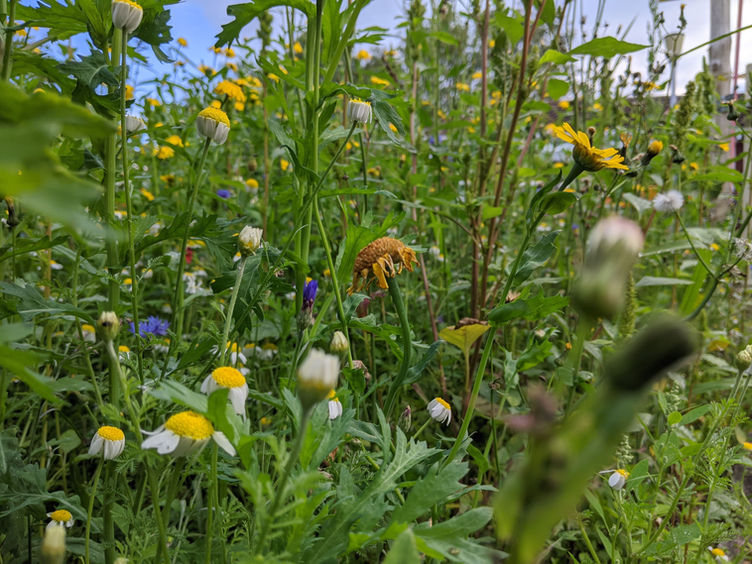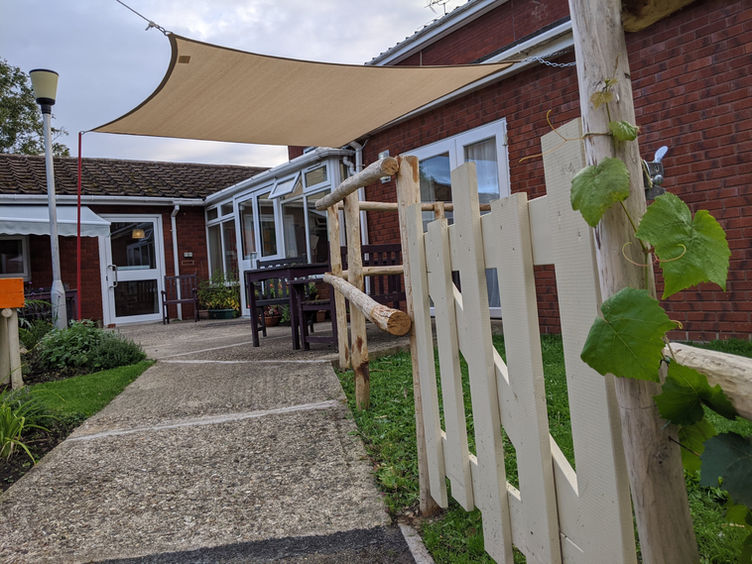Dementia Garden, Berkshire
This garden was a dual purpose creation for use by a specialist dementia unit and a residential care home. Areas of edible planting and accessible paths link activities and separate areas, allowing for multiple different users to have their needs met at the same time in different locations within the space.
Wildflower patches, fruit trees, reinforced grass and reconditioned hard landscaped paths lead from activities such as a rainbow bespoke outdoor instrument to a solar powered water feature, built from reclaimed materials and edible plants.
The layout consists of smaller loops and a larger figure of eight route which enables and encourages wandering and movement through the garden, reducing chance of confusion and increasing independence in the space. The paths are zimmer-frame and wheelchair friendly, and also provide a safer CFH (critical fall height) than traditional, more expensive path options. The grass grows through the matting, offering year-round use and the immersion of being amongst more greenery, but safely. They also increase the 'green to grey ratio', grey being hard landscaped areas - for example patios. Having a high green to grey ratio plays an important role in the healing nature of outdoor spaces - a particular challenge for this garden set in an urban courtyard.
Three reclaimed timber raised beds are built with space underneath such that they are suitable for both wheelchair and standing access. Planted within the beds are three patches of different, carpeting low-growing scented plants that when touched release a scent, including a Causican Mint, Creeping Thyme and Chamomile. Apart from these plants the beds are un-planted, offering a designated and manageable zone for the staff and residents to plant annual veg and bedding plants in.
The garden features regular signage, on a yellow background, as it is one of the last colours that can still be successfully seen by aging eyes. This reassures residents if they become confused or lost. It also gives purpose to their use of the garden and the opportunity for autonomous decision making, something proven to be important in dementia care and the reduction of the onset of dementia.
All the planting is low-maintenance, non-toxic and mainly consists of edible perennial plants with the exception of a couple of varieties, chosen for their value as cut flowers to be brought into the home, so that those who are inside can still benefit from the garden. Included throughout is planting for scented sensory stimulation giving the opportunity for staff and residents to accidentally brush past the plants and release their scent but also to engage in activities such as 'guess the herb'. A trained Oregan Thornless Blackbery, chosen for its taste and ornamental leaf shape, offers both beauty and stimulation from both picking the fruits and eating them. Wild strawberries offer a low growing berry producing ground cover, while suppressing weeds in the process.
A lot of the design considerations are based around increasing engagement and therefore often physical activity and time spent outdoors, which has numerous proven benefits from better sleep habits to increased recovery time from illnesses. A clearly identifiable red post box, is situated in the centre of the garden, in view from inside the home. This acts as both an activity-stimulating feature, as residents can write letters to loved ones from inside, and as an enticing feature, bringing residents outside to physically post their letter. Once outside, there is then opportunity for the potential of more outdoor activity and stimulation.
The washing line is complete with two lines, one for wheelchair access and another for standing. Its placement in the garden gives the residents the opportunity to start hanging out/bringing in the washing, providing the potential for engagement in physical exercise as well as a reminiscent activity.
























